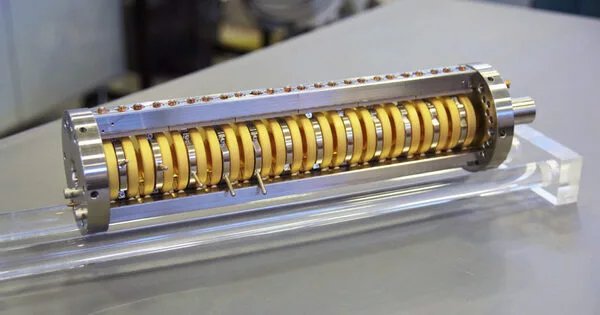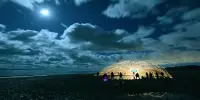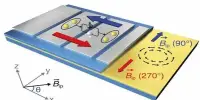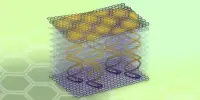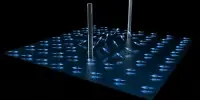To address a long-standing mystery about how long a neutron can “live” outside of an atomic nucleus, physicists entertained a wild but testable theory positing the existence of a right-handed universe parallel to our left-handed universe. They devised a mind-boggling experiment at the Department of Energy’s Oak Ridge National Laboratory in an attempt to detect a particle that has been speculated about but not observed. If discovered, the “mirror neutron” – a dark-matter twin to the neutron – could explain a discrepancy between the results of two types of neutron lifetime experiments and provide the first observation of dark matter.
“Dark matter remains one of the most important and puzzling questions in science — clear evidence we don’t understand all matter in nature,” said ORNL’s Leah Broussard, who led the study published in Physical Review Letters.
The nucleus of an atom is made up of neutrons and protons. They can, however, exist outside of nuclei. Last year, co-author Frank Gonzalez, now at ORNL, led the most precise measurement of how long free neutrons live before decaying into protons, electrons, and antineutrinos using the Los Alamos Neutron Science Center. The answer — 877.8 seconds, give or take 0.3 seconds, or just under 15 minutes — suggested a flaw in particle physics’ Standard Model. That model describes the behavior of subatomic particles like the three quarks that comprise a neutron. Quark flipping causes neutron decay into protons.
“The neutron lifetime is an important parameter in the Standard Model because it is used as an input for calculating the quark mixing matrix, which describes quark decay rates,” said Gonzalez, who calculated the ORNL study’s probabilities of neutron oscillations. “If the quarks do not mix as expected, it suggests new physics beyond the Standard Model.”
To determine the lifetime of a free neutron, scientists use two methods that should yield the same result. One method involves trapping neutrons in a magnetic bottle and counting their disappearance. The other counts protons in a beam that appear as neutrons decay. Neutrons appear to live nine seconds longer in a beam than they do in a bottle.
The neutron lifetime is an important parameter in the Standard Model because it is used as an input for calculating the quark mixing matrix, which describes quark decay rates. If the quarks do not mix as expected, it suggests new physics beyond the Standard Model.
Gonzalez
Over the years, perplexed physicists have considered many reasons for the discrepancy. One theory is that the neutron transforms from one state to another and back again. “Oscillation is a quantum mechanical phenomenon,” Broussard said. “If a neutron can exist as either a regular or a mirror neutron, then you can get this sort of oscillation, a rocking back and forth between the two states, as long as that transition isn’t forbidden.”
Using a novel disappearance and regeneration technique, the ORNL-led team conducted the first search for neutrons oscillating into dark-matter mirror neutrons. The neutrons were created at the Spallation Neutron Source, a user facility of the DOE Office of Science. A neutron beam was directed to SNS’s magnetism reflectometer. Michael Fitzsimmons, a physicist with appointments at ORNL and the University of Tennessee, Knoxville, used the instrument to boost oscillations between neutron states by applying a strong magnetic field. The beam then collided with a “wall” made of boron carbide, a strong neutron absorber.
If the neutron oscillates between regular and mirror states, the neutron state will interact with atomic nuclei and be absorbed by the wall when it hits it. However, if it is in its theorized mirror neutron state, it is dark matter and will not interact.
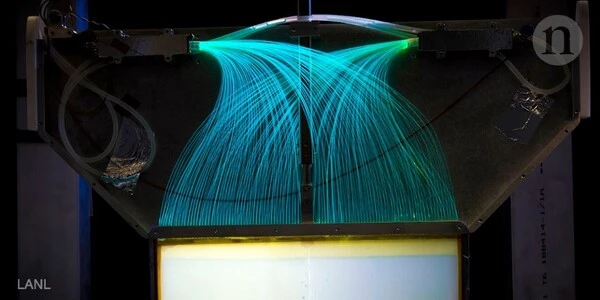
Only mirror neutrons would be able to pass through the wall and reach the other side. It would be as if the neutrons had passed through a “portal” to some dark sector, a figurative term used in physics. However, the press reporting on previous related work had fun with the concept, comparing the theorized mirror universe Broussard’s team is exploring to the “Upside Down” alternate reality in the TV show “Stranger Things.” The team’s experiments were not exploring a literal portal to a parallel universe.
“The dynamics are the same on the other side of the wall, where we try to induce what are presumably mirror neutrons – the dark-matter twin state – to turn back into regular neutrons,” said co-author Yuri Kamyshkov, a UT physicist who has long investigated neutron oscillations and mirror neutrons with colleagues. “If we see any regenerated neutrons, it could be a sign that we’ve witnessed something truly extraordinary. The discovery of dark matter’s particle nature would have enormous ramifications.”
Matthew Frost of ORNL, who received his doctorate from UT working with Kamyshkov, performed the experiment with Broussard and assisted with data extraction, reduction and analysis. Frost and Broussard performed preliminary tests with help from Lisa DeBeer-Schmitt, a neutron scattering scientist at ORNL.
Lawrence Heilbronn, a nuclear engineer at UT, characterized backgrounds, whereas Erik Iverson, a physicist at ORNL, characterized neutron signals. Through the DOE Office of Science Scientific Undergraduate Laboratory Internships Program, Michael Kline of The Ohio State University figured out how to calculate oscillations using graphics processing units — accelerators of specific types of calculations in application codes — and performed independent analyses of neutron beam intensity and statistics, and Taylor Dennis of East Tennessee State University helped set up the experiment and analyzed background data, becoming a finalist in a competition for this work.
The conclusion: There was no sign of neutron regeneration. “One hundred percent of the neutrons stopped; zero percent passed through the wall,” Broussard said. Regardless, the outcome is important for the advancement of knowledge in this field.
With one mirror-matter theory debunked, scientists turn to others to try to solve the neutron lifetime puzzle. “We’re going to keep looking for the cause of the discrepancy,” Broussard said. She and her colleagues will use the High Flux Isotope Reactor at ORNL, a DOE Office of Science user facility. HFIR’s ongoing upgrades will allow for more sensitive searches because the reactor will produce a much higher flux of neutrons and the shielded detector at its small-angle neutron scattering diffractometer will have a lower background.
